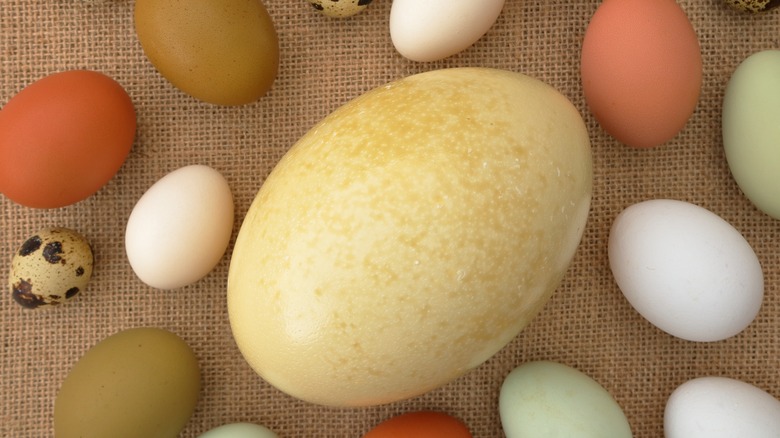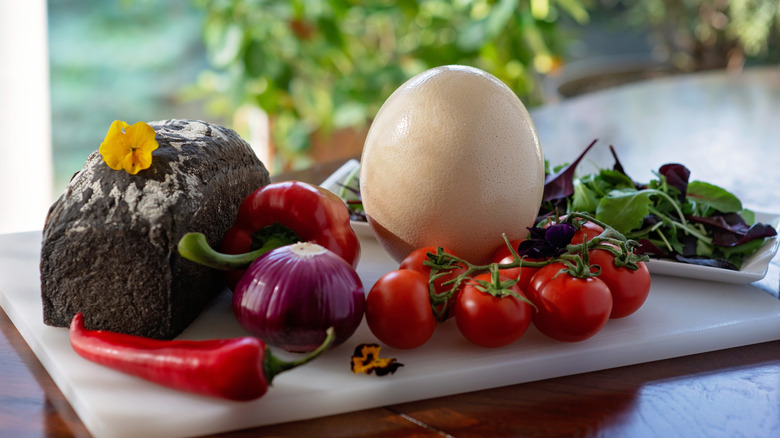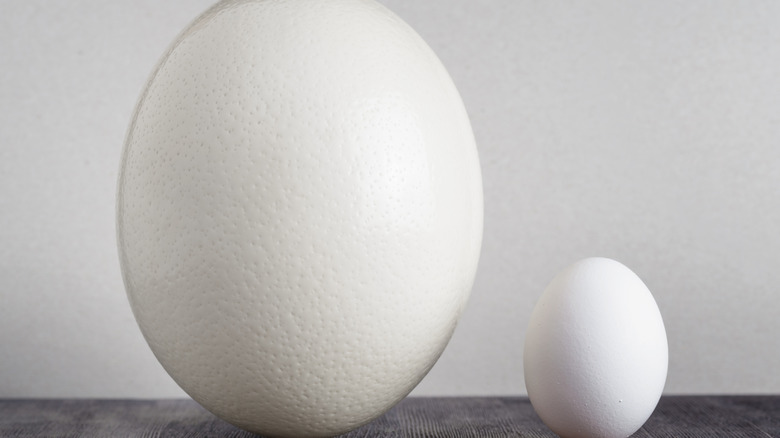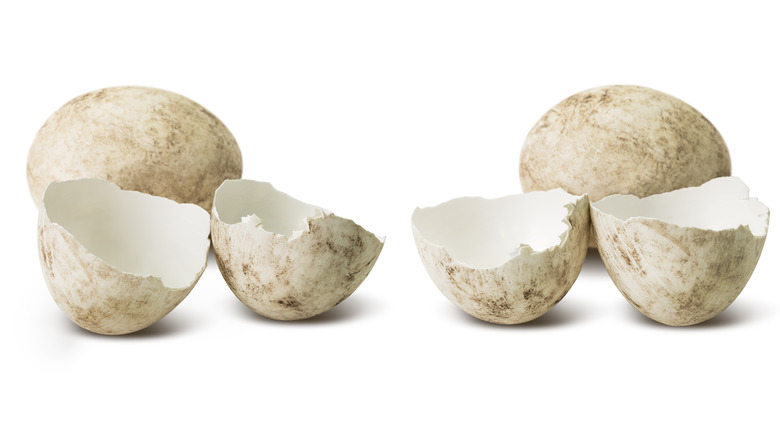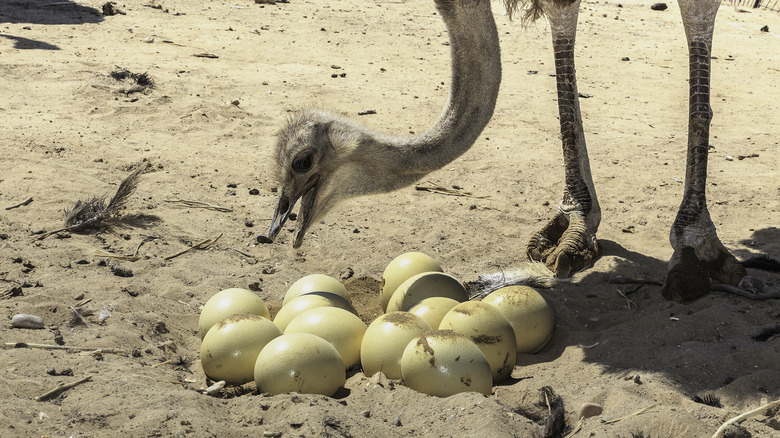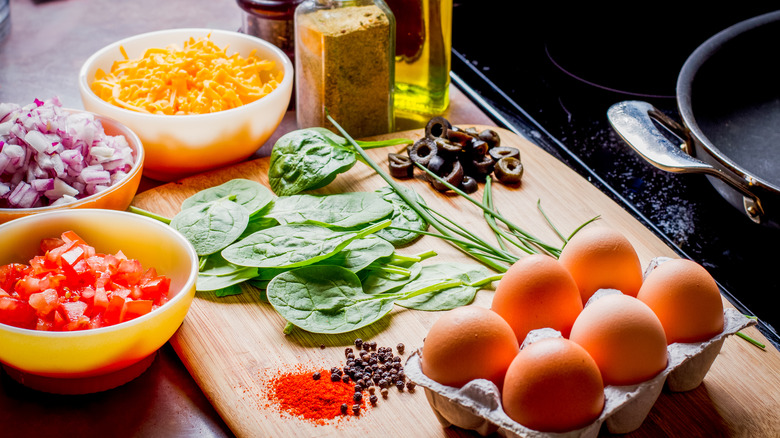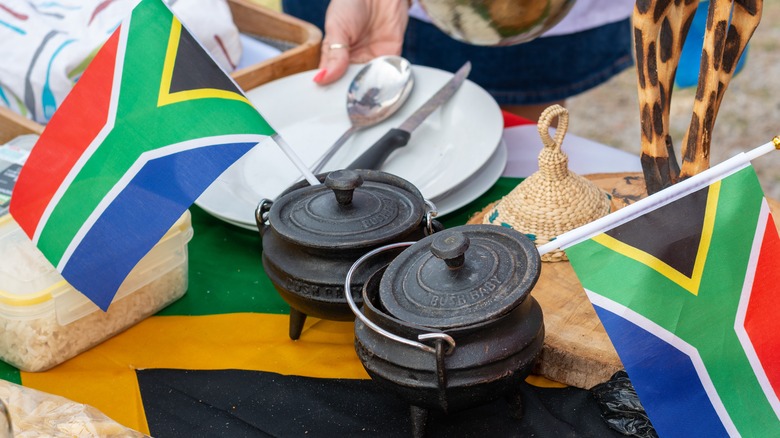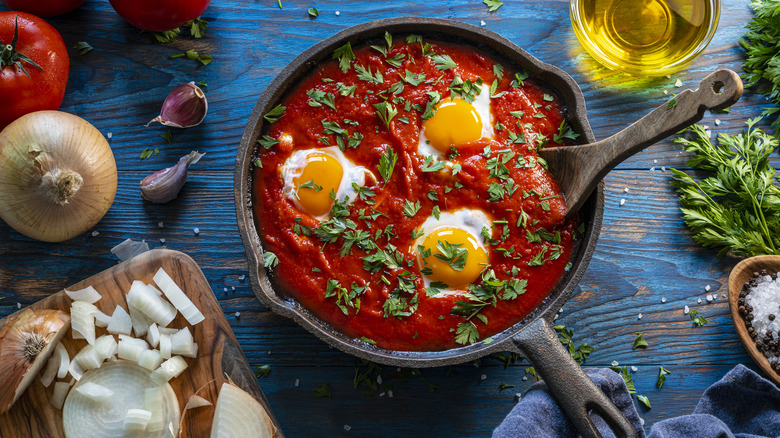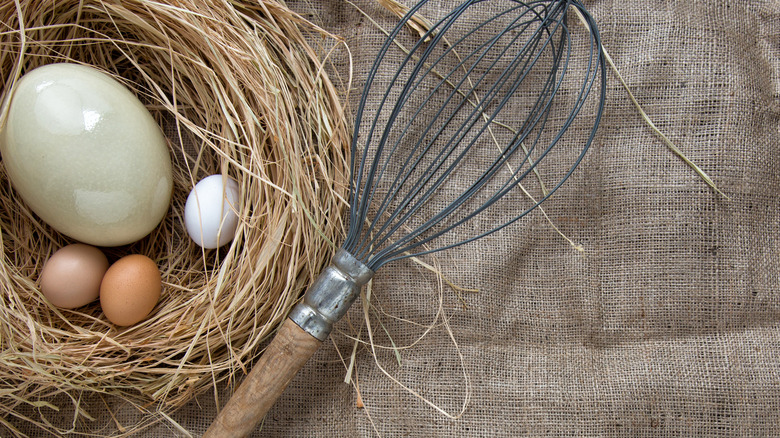10 Facts You Need To Know About Eating Ostrich Eggs
You're probably quite familiar with chicken eggs: how they taste, what they look like, and the many ways to cook them on their own or with other foods. But what about the mysterious and mythical ostrich egg? At first glance, ostrich eggs might not seem like a practical snack, but their health benefits make them more than just a fun food experiment. And eating them isn't a new thing — they have a long history woven through many cultures and locales as a food for royalty as well as everyday folks.
Their size has made it difficult for ostrich eggs to become a common household food in most of the world, so methods for cooking and eating them aren't as commonplace as they are with chicken eggs. It might seem daunting to approach such a large food with your regular pots and pans and spatulas, but you aren't alone in the dark here. Here are a few things you'll want to know before you get started on your exotic egg adventure.
Ostrich eggs are full of nutrients
Ostrich eggs, like most other eggs, have high amounts of vitamins and minerals. Due to the quantity and diversity of the nutrients and their respective health benefits, ostrich eggs can make for a more nutritious meal (as part of a dish or on their own_ and can provide you with your daily amounts of a handful of vital nutrients.
The eggs are loaded with omega-3 fatty acids, which have many health benefits like improved vision and heart health, per the Cleveland Clinic. Because most people don't get enough of these fatty acids — and because ostrich eggs are so large — they make for a great source of this valuable nutrient. Ostrich eggs contain around 2,000 calories on average, as well as 235 grams of protein. That's more than enough of your daily average for both of those nutrients, so it might be wise to split one ostrich egg up into a couple of meals throughout the day (or week). Ostrich eggs also have high amounts of magnesium, calcium, iron, and potassium, as well as a few lesser-known but equally important nutrients like riboflavin and folic acid. So, despite being high in calories, the ostrich egg offers a vast number of benefits for the body.
The eggs are massive
One ostrich egg can weigh up to five or six pounds, with an average weight of three pounds. They're the largest egg laid by any bird (but the smallest egg when compared to the size of the bird that lays it), and you'll want to account for those proportions with any recipe you're planning to try out. With the average chicken egg weighing a little more than two ounces, that means one ostrich egg is equivalent to about 20 to 25 regular chicken eggs in volume!
On average, an ostrich egg will be roughly six inches long and five inches across, making it just a little larger than your hand. Eating an entire ostrich egg by yourself in one sitting might be a challenge, and not worth the time and money spent on buying and preparing the egg, so make sure to have a few people around to help you conquer the enormous task of gobbling one up.
In many ways, ostrich eggs are similar to the eggs you normally eat
Besides the obvious size difference, ostrich eggs look, taste, and cook quite similarly to chicken eggs. They contain many similar nutrients, although chicken eggs usually have more vitamins A and E, while ostrich eggs have more magnesium and iron. For the most part, chicken eggs and ostrich eggs can be used interchangeably in recipes due to their similarities, though you might notice that ostrich eggs have a more intense taste.
Ostrich eggs can be used in baking just like other eggs, and whatever you don't use for your meal can be used to bake something for dessert. All of your favorite ways to cook eggs (scrambled, hard-boiled, sunny side up) can also be applied to cooking an ostrich egg, but each style of cooking will present its own challenges. On their own, ostrich eggs are said to have a very buttery taste, so plan ahead when cooking so that you can balance out the taste with something more subtle.
The shells are thick and sometimes require tools to open
You won't want to try cracking your ostrich egg on the side of the bowl. The shells can be up to 5 millimeters thick, and usually require some kind of tool, like a drill or kitchen saw, to open them up. Extensive research on ostrich eggs summarized in World's Poultry Science Journal found that their average breaking strength (how much pressure it would take to break one) is 121 pounds. For comparison, the chicken egg only takes about 12 pounds! The thicker shell also means that ostrich eggs will last longer before going bad.
The shells are so strong that they've been used as decorative gifts or as tools for thousands of years in many different parts of the world, and that tradition persists today. There are many ways you can use your eggshell once you're done eating the insides, and you'll probably want to after all the work of procuring the egg and then cooking it, perhaps as a testament to surmounting the awesome task of eating something so large.
Cooking an ostrich egg can be difficult
Depending on how you cook the egg, preparing this food can take a very long time. Hard boiling takes about 90 minutes, and a regular boil can take up to 60 minutes. If you want to scramble the entire egg, you'll need to find a pan massive enough to hold the yolk and some large utensils as well.
All of this can make it seem like cooking an ostrich egg is impractical, but a little bit of creative thinking can go a long way. Scrambling the egg ends up being the easiest option for cooking, and by cutting a small hole in the side of the egg and pouring it into your pan, you can scramble it up in a normal amount of time. The key to cooking an ostrich egg is preparation: you'll want to have the tools to open it and cook it ready, as well as a concrete plan on how you'll be preparing it.
Ostrich eggs are rare and hard to obtain
The ostrich is native to parts of central and southern Africa, though you don't have to live there to get your hands on an ostrich egg. There are many small, independent farms around the world that raise ostriches for their meat and their eggs. Despite this, it's not entirely simple to find a good ostrich egg source. Many farms that sell ostrich meat won't sell their eggs due to the price of shipping and the difficulty of shipping them because of their size and weight. If you can find a farm that is selling ostrich eggs, they aren't exactly cheap. They can range from $40 to $100 for a single egg, which might be worth it, considering their size and health benefits.
There were 258 ostrich farms in the U.S. in 2012, though this number has been steadily decreasing. Myriad environmental factors are encroaching on wild ostriches, and the number of farms breeding and raising them seems to be dwindling, so it's important to make sure you're sourcing your eggs from a good farm.
No matter how you cook it, you'll want to prepare a lot of ingredients
Because ostrich eggs are so large, you'll want to prepare more than the average amount of your common kitchen ingredients like salt, butter, and spices. A recipe for a scrambled ostrich egg can call for up to 150 grams of butter, so make sure the "pinch" of salt you might add to a regular omelet is more like a handful! Different recipes require different amounts of these ingredients, so you'll want to plan ahead when shopping or find a recipe that matches your availability.
For example, a poached or boiled egg doesn't necessarily require the same amount of butter or oil as scrambled eggs, though those recipes might be a little more complicated if you aren't used to those processes. Omelets are a classic and easy way to cook eggs, but an omelet recipe will probably require the largest amount of additional ingredients. There are plenty of ways of making an omelet, so once you have large enough utensils and the right ingredients, nothing stands in your way of cooking a delicious ostrich egg.
There are a few traditional ways to cook an ostrich egg
Where better to look for a recipe for an ostrich egg than the place this unique bird is native to? A traditional South African omelet recipe can be an easy way to cook an ostrich egg at home. Tomatoes, onions, and bell peppers are crucial ingredients for this kind of omelet, and you can add some popular South African spices (like curry powders or peri-peri) for a more diverse palate. Due to the size of the ostrich egg, they are often cooked outside on a traditional South African grill called a braai. These grills are perfect for the ostrich egg because they are large and open-flame, and you won't have to worry about the size of your kitchen.
The most traditional use of ostrich eggs isn't directly related to eating at all. Ostrich egg shells have been used for thousands of years as decorations, containers, or as part of religious practice. In the past, the decorated shells were offered as gifts for living pharaohs or as parting gifts for the deceased. The way the shell was used depended on where you were, and these traditions have continued into the modern day. Once you're done cooking your own ostrich egg, you can take part in this by not just throwing your eggshell away. Whether it's a tool or a gift, using the shell is a vital part of the ostrich egg experience.
Forget the classic recipes and try getting experimental
There are many well-known ways to cook eggs, but with something as unique as ostrich eggs, why would you want to tread a well-traveled path? Come up with something on your own or take inspiration from a recipe you wouldn't traditionally cook. An ostrich egg fatty redux is one option that uses different ingredients and an oven rather than a stove. Think of it like a Wellington made with an ostrich egg in place of steak! Be aware that this is a complex recipe that requires some unconventional cooking knowledge outside of the relative simplicity of making eggs. If you find yourself with ostrich eggs in your fridge, chances are you're comfortable with some of these advanced techniques.
When you're feeling fancy, you can elevate the ostrich egg beyond breakfast and try making a savory custard by steaming the insides and adding rare garnishes like caviar. Almost any way that you can cook a chicken egg, you can also cook an ostrich egg. So, if you are getting bored with the same old methods, try mixing ostrich eggs into your favorite frittata or cloud egg recipe.
You can bake with an ostrich egg
Ostrich eggs aren't just a staple for savory breakfast dishes and can be used to bake desserts just like chicken eggs can be. They are great for baking because they are often fluffier when cooked and have a sweet, buttery taste. If you can get your hands on an affordable ostrich egg, it might just be cheaper (and more fun) than buying a few dozen eggs for large-batch baking recipes. To start with, you can replace regular eggs with ostrich eggs in any recipe, as long as you take into account that one ostrich egg yolk is equal in weight to about two dozen eggs. Once you do the simple math, you'll want to consider the slight difference in flavor when adding sugar and butter.
Although ostrich eggs can be a fun addition to your cake recipe, you'll still want to be careful when baking with them. Baking is much different than cooking, say, a scramble or an omelet. For example, if you use three or four eggs for an omelet, the primary difference between them will be the size of the omelet. But if you change the number of eggs in a baking recipe, it can alter much more than just the size, so baking with an ostrich egg isn't recommended for first-time bakers.
